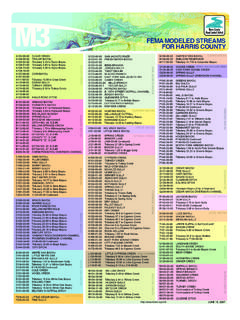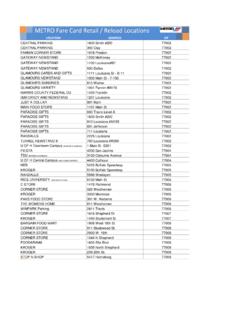Transcription of Buffalo Bayou - HCFCD
1 Buffalo BayouWatershedThe Buffalo Bayou watershed is primarily located in west-central Harris County with a small portion crossing into Fort Bend County. Rainfall within the 102 square miles of the Buffalo Bayou watershed drains to the watershed s primary waterway, Buffalo Bayou ( HCFCD Unit W100-00-00). Buffalo Bayou travels through heavily wooded residential areas and much of the Bayou remains in a natural state. Near downtown Houston, White Oak Bayou ( HCFCD Unit E100-00-00) flows into Buffalo Bayou . Just east of downtown Houston near the Turning Basin, Buffalo Bayou becomes the Houston Ship Channel. There are 106 miles of open waterways in the Buffalo Bayou watershed, including Buffalo Bayou and its major tributaries, such as Rummel Creek ( HCFCD Unit W156-00-00), Soldiers Creek ( HCFCD Unit W141-00-00), Spring Branch ( HCFCD Unit W140-00-00) and Turkey Creek ( HCFCD Unit W167-00-00).
2 Based on the 2010 Census, the estimated population of the Buffalo Bayou watershed is 444, OverviewWhat is a watershed?A watershed is a geographical region that drains to a common Bayou , creek or other ProjectsIn the past 20 years, the Harris County Flood Control District has spent nearly $57 million on projects in the Buffalo Bayou watershed. Some active projects include repairing erosion, evaluating future flood damage reduction projects, and improving the Conveyance Restoration at Buffalo Bayou Park In July 2010, the Flood Control District began construction on a maintenance project to remove sediment from and repair the banks of Buffalo Bayou from Sabine Street to Shepherd Drive. The first reach of the project, referred to as the Buffalo Bayou Pilot Project, spanned the section of the Bayou from Sabine to 1,200 feet upstream and was completed in August 2010.
3 The pilot project was met with public support and demonstrated the type of work the Flood Control District planned for the larger Channel Conveyance Restoration at Buffalo Bayou Park project, which began in August 2012. This project spans approximately 2 miles of the Bayou from Shepherd to 1,200 feet upstream of Sabine. Construction activities include removing sediment, restoring and reshaping the Bayou s banks, removing undesirable vegetation, and installing bank stabilization and protection material in key locations. An extensive planting plan will be implemented following construction to plant trees and other native vegetation. The project is expected to be complete in Buffalo : A Study of Buffalo and Lower White Oak Bayous Charting Buffalo is a regional strategic approach that identifies options for flood damage reduction improvements and demonstrates how these options could be integrated with other community and environmental interests.
4 The study area includes 32 miles of Buffalo Bayou eastward from the Barker Reservoir through downtown Houston to the Houston Ship Channel Turning Basin. Also included in the study area is seven miles of lower White Oak Bayou from North Loop 610 West to the point at which it joins Buffalo Bayou near downtown Houston. The study proposes a partnership approach to implementing strategic stormwater detention basins that could be used for both riverine flood reduction and drainage mitigation. While the Charting Buffalo study is funded by the Flood Control District, many organizations that are already investing resources in the area are participating in the study. Preliminary flood damage reduction options have been identified by the study, and the Flood Control District is currently determining how to move forward with additional study efforts.
5 For more information, visit Park Demonstration Project Erosion has caused bank failures, loss of public and private land and an adverse effect on water quality along Buffalo Bayou , including the stretch adjacent to Memorial Park. The Flood Control District is partnering with the City of Houston and River Oaks Country Club on a proposed Bayou restoration project titled the Memorial Park Demonstration Project. The purpose of this proposed project is to help repair erosion, stabilize slopes, reduce sediment deposition, preserve flood capacity and improve water quality, while demonstrating the benefits of natural channel design techniques. The Flood Control District scheduled a public meeting for late 2013 to provide an overview of the proposed project design. The proposed project also requires a Corps of Engineers individual permit, as well as a public hearing under Texas Parks and Wildlife Code, Chapter 26 to determine if protected park land (Memorial Park) can be used for other purposes.
6 Both of these processes include the opportunity for public input. If these steps are successful, the final design could be completed by fall 2014, and construction could begin by the end of 2014. The project would take approximately 12 months to Bayou watershed Drainage Area Watershed Population Open Channels 102 square miles 444,602 106 milesWhat We DoThe Harris County Flood Control District was initially created in 1937 to serve as a local partner to the Army Corps of Engineers to build projects that reduce flooding risks and damages from major bayous and creeks in Harris County. While the District still fulfills that role, its responsibilities and capabilities have expanded over the years. The mission of the Flood Control District is to provide flood damage reduction projects that work, with appropriate regard for community and natural values.
7 The Flood Control District accomplishes its mission by devising flood damage reduction plans, implementing the plans and maintaining the 2013 For more information about the Buffalo Bayou watershed, its studies and projects, or the Flood Control District, please visit our website at To ask a question or comment on a project, please call the Harris County Flood Control District s Project and Study Information Line at (713) Bayou between Sabine Street and Shepherd DriveW129-00-00 Channel Enclosure Project The Flood Control District recognized the need for repairs to the man-made drainage channel formally identified as HCFCD Unit W129-00-00 and launched a three-phase reconstruction project in 2004. The drainage channel runs adjacent to the Union Pacific Railroad tracks just inside West Loop 610 South. The first phase of the project consisted of rebuilding the drainage channel, which had experienced severe erosion, between San Felipe Street and Buffalo Bayou .
8 This $ million project enclosed the channel with dual 12-foot by 10-foot reinforced concrete box culverts and was completed in 2006. In the second phase, which began in August 2011, the Flood Control District is enclosing the section of the drainage channel from San Felipe to Richmond Avenue in dual 12-foot by 10-foot reinforced concrete box culverts. As part of the second phase, the bridge at Westheimer Road was reconstructed in April 2013, and the bridge at San Felipe was reconstructed in October 2013. This phase is estimated to cost $ million, with the City of Houston contributing funds to the bridge projects. The third phase will consist of similar work from Richmond to Westpark Drive. Design will begin in 2014 and construction is expected to be funded in 2016. When all three phases are complete, the structural integrity of the system will be greatly improved, reducing the risk of flooding in surrounding neighborhoods and commercial areas.
9 For more information on this project, please visit Canal Bypass Channel Project At the confluence of White Oak and Buffalo bayous near downtown Houston, a narrow channel, turbulence at the confluence, and severe channel bends restrict the flow of stormwater during heavy rainfall events. A North Canal Bypass Channel is being considered that would help reduce the risk of flooding to downtown Houston and would also provide flood damage reduction benefits to areas farther upstream of downtown Houston along both White Oak and Buffalo bayous. The Flood Control District is in the process of investigating the concept, and property acquisition, design and construction phases are not yet fully funded. If implementation is feasible, there will be opportunities for the Flood Control District to work with the community on the design of the and Topographic Survey, South Bank of Buffalo Bayou This survey will catalog existing vegetation and natural ground elevations on the Bayou s south bank within Flood Control District right of way from Eldridge Parkway to Wilcrest Drive.
10 Data collected will provide a preliminary assessment of the physical and environmental constraints associated with potential use of the reach for appropriate flood damage reduction projects. This surveying effort is limited to data gathering; no construction is funded or scheduled in the and Completed Maintenance ProjectsThe Harris County Flood Control District oversees more than 2,500 miles (about the distance from Los Angeles to New York City) of bayous and creeks and routinely performs maintenance projects to repair channels and stormwater detention basins that have experienced erosion, slope failure and sediment accumulation. The Flood Control District also plants native grasses, wildflowers and trees to help reduce erosion and mowing and Vegetation Management The Flood Control District performs routine cyclical maintenance, including mowing right of way along bayous, creeks and stormwater detention basins in the Buffalo Bayou watershed.











